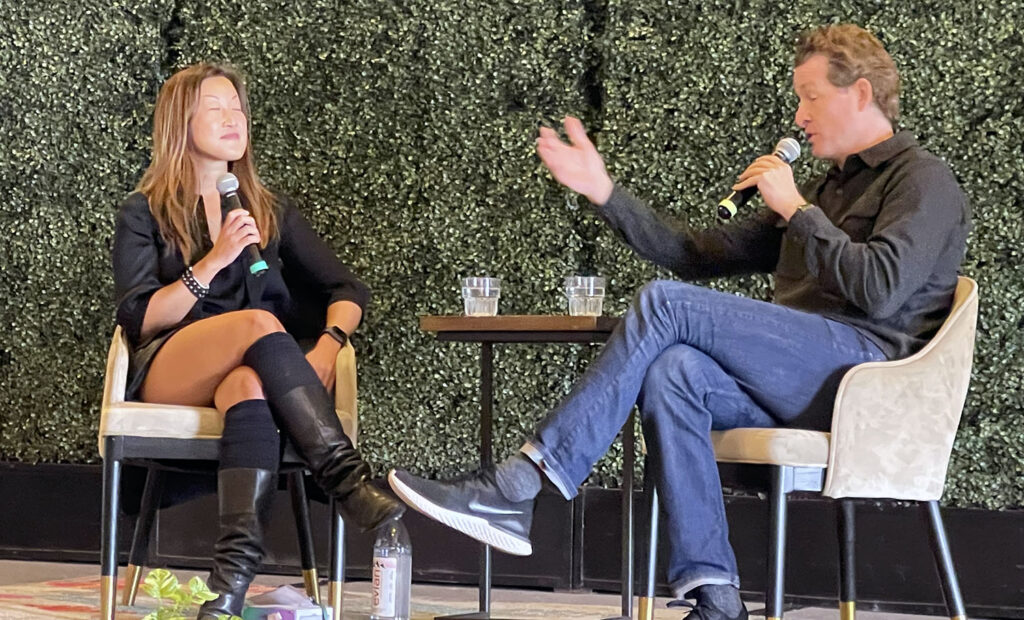
By Alliance President Terry Gips
Can a business be 100% committed to the planet? The answer is yes. Patagonia CEO Ryan Gellert shared how it’s creating an inspiring new model for business during an interview (“Earth is now our only Shareholder”) with American Sustainable Business Network (ASBN) Co-Chair Seungah Singh at the ASBN Conference last week in San Diego. Gellert shared the inside story of how founder Yvon Chouinard planned his shift from ownership with he and his family recognizing they had enough money but wanted to keep Patagonia’s values so they didn’t want to take the company public or simply sell it.
Instead, they charted a new course guided by one thought: “The climate crisis is an existential crisis for humanity created by humanity. We have to do everything we can to address it.” Gellert had discussions with all 1,547 employees globally. Two structures emerged: a nonprofit giving nearly all of Patagonia’s profits to support the environment ($50 million annually now and likely $100 million in the future) and a purpose trust to protect its values. The nonprofit owns 98% of Patagonia’s value and no control. The trust has 2% of the value and 100% of the control “to make sure no one screws it up.”
As Gellert shared, “One of Patagonia’s great strengths is a sense of self. With this transition and structure, we’ve taken our values built over 49 years and wed them with our financial value. It’s messy as hell…We’re in business to save our planet. That gives us a consistent North Star. We have the money, people and resources. Having a commitment to using business to save the planet is clarifying. So, we can then ask, what is the best use of our time?”
Gellert shared about the importance of supporting movements like BCorps and ASBN that are committed to fixing what he said is a “deeply flawed” capitalist system. He minced no words when critiquing the outdoor apparel industry’s poor practices and minimal action: “It’s taken 35 years for more than a handful of companies in the outdoor industry to commit to 1% for the Planet. Don’t look to this industry for leadership. The industry is far too extractive of the natural world.”
When asked about greenwashing, Gellert said there’s lots of it: “Business is not sustainable and it’s certainly not green and that includes Patagonia. Our goal is to become more regenerative. We show up for work every day trying to do everything we can do.”
“We have a relentless focus on quality and looking at resources and their impact,” Gellert emphasized. “We have 120 people in Reno doing full-time product repair. We’ll take 100% responsibility for every product we’ve put out into the world so there’s real circularity in supply chains.”
When asked what’s next, Gellert expressed concern about the environmental impacts from over-consumption and said that Patagonia won’t create “new products and colors unless they’re really innovative. Footwear is an obvious example. We’d need to be innovative to go into it so we’re not.”
He also shared how Patagonia is looking to protect eco-systems around the world where they can make a difference. They support 30 by 30, the global effort to protect 30% of terrestrial and marine habitat by 2030, and want to scale to 50 by 50. He pointed to a Memorandum of Understanding with Albania to pass legislation protecting a key river. He added, “All of our regions are looking at scaling around marine protected areas. We’re also creating a new protective area at southern tip of Argentina. We constantly ask how we can take a toe hold and turn it into a handhold and then create a ledge.”
Gellert concluded by saying, “Our biggest impact in 49 years is modeling a different form of business by operating unapologetically as a for profit business and being transparent and open and sharing. We open source our approaches to competitors because we’re trying to take a nasty outdoor apparel industry and show people how to do things differently.”
